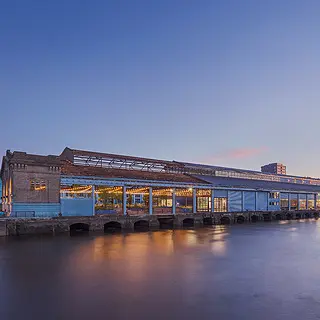
An Old Philadelphia Pier Goes From Defunct to Delightful
Editors' note: Please check Cherry Street Pier's website for updates on COVID-19 related closures.
It’s easy to know where to go once you get inside Cherry Street Pier: Just follow the train track embedded in the structure’s concrete floors. The rehabbed Philadelphia warehouse and shipping pier reopened in 2018 and was undergoing more updates as of press time, but it’s held fast to its industrial character.
When the pier was built on the Delaware River in 1919, it was used for offloading fruits and vegetables shipped to Philadelphia. The produce was transferred onto trains that took it into the city for retail sale. Over time, shipping gravitated to other parts of the riverfront, and the 55,000-square-foot structure (then known as Municipal Pier 9) was used for storage.
By 2012, the Delaware River Waterfront Corporation (DRWC), a quasi-public nonprofit charged with revitalizing the area, decided to do something different with the property. “We were in contact with some arts organizations who were looking for unconventional spaces for events or art installations and exhibits,” says Lizzie Woods, vice president of planning and capital programs at DRWC. “It got us thinking about how to repurpose this incredible architectural space.”

photo by: Sam Oberter
Artist's studios in former shipping containers line an interior wall of Cherry Street Pier. Top photo: As part of Cherry Street Pier’s $5 million renovation, the team repaired damage to the underwater piles that support it. The pier sits on the Delaware River in the Old City neighborhood of Philadelphia.
Groundswell Design Group and Interface Studio Architects (ISA) worked together to find a dynamic way to reuse the space: artist’s studios made of shipping containers. The studios are lined up on the south side of the interior, leaving plenty of space for temporary markets and exhibitions. The pier is part of the Old City Historic District, and its century-old street-facing head house and much of the other exterior detailing were saved. Crews are currently repairing and replicating clerestory windows, and in January they replaced non-historic metal entry doors with glass ones.
In a move supported by the Philadelphia Historical Commission, the design team had most of the original metal doors on the north side removed and replaced with glass garage doors to let in light and air. They also removed part of the roof, transforming the river end of the pier into an open-air garden. The steel roof structure remains intact, but now a portion of it has been waterproofed and exposed to the elements.
Visitors to the revamped pier can watch artists at work, attend a farmers market or art exhibition, or relax in the landscaped garden. Admission is free, and tenants are charged below-market rates to ensure the presence of emerging artists. “It’s unusual to have an arts space where the public is coming by, almost like you’re on a street,” says ISA’s Brian Phillips. “It’s informal; there are kids around. People can feel comfortable.”
Please take our short survey on the content of Preservation magazine.



